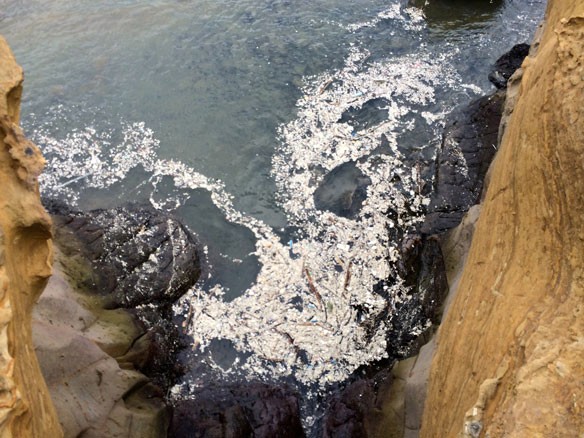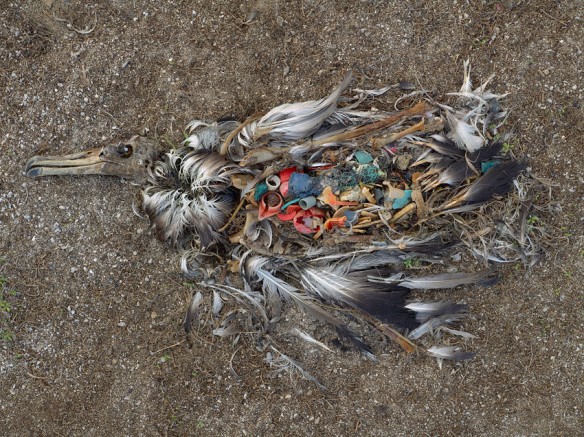
Photograph: © SAF — Coastal Care.
“Whether plastics present a unanimously accepted and proven toxic challenge to marine life, and subsequently to humans, is one of the biggest challenges facing scientists right now.
All sea creatures, from the largest to the microscopic organisms are, at one point or another, swallowing the seawater soup instilled with toxic chemicals from plastic decomposition. Much of ocean’s life is in the microscopic size range and zooplankton is the base of the food chain. As environmentalists remind the world’s population: “…We are eating fish that have eaten other fish, which have eaten toxin-saturated plastics…”
—Claire Le Guern, author: “When The Mermaids Cry: The Great Plastic Tide,” Coastal Care ©-2009.
Excerpts;
Fish are “stuffing themselves” on plastic, but scientists are still trying to figure out what effect that might have on those of us who eat seafood…
Read Full Article, Guardian UK (08-31-2016)
Microplastic particles threaten fish larvae, Science Daily (06-03-2016)
Researchers have found that larval fish exposed to microplastic particles during development displayed changed behaviors and stunted growth which lead to greatly increased mortality rates. The researchers discovered that larval perch that had access to microplastic particles only ate plastic and ignored their natural food source of free-swimming zooplankton…
Plastic Contaminates Ocean Sourced Table Salt, Scientific American (10-30-2015)
When researchers analyzed fifteen brands of common table salt bought at supermarkets across China, they found among the grains of seasoning micro-sized particles of plastic. The highest level of plastic contamination was found in salt sourced from the ocean…
The Plastic Found In a Single Turtle’s Stomach, Independent UK (03-24-2011)
Death by Plastic: Is Ocean Plastic Garbage Killing Whales?, Independent UK
From the coasts of California to Adriatic, Tasmania or Normandy, millions of tonnes of plastic debris dumped each year in the world’s oceans, could pose a lethal threat to whales, according to a scientific assessment to be presented at the International Whaling Commission this week. Ingestion of plastic refuse is emerging as a serious cause of disability and death for the large ocean-dwelling mammals…
Global Impact of Debris on Marine Life Studied, (02-19-2015)
Nearly 700 species of marine animal have been recorded as having encountered humanmade debris such as plastic and glass according to the most comprehensive impact study in more than a decade…
90 Percent of Seabirds Have Plastic in Their Stomachs, Newsweek (09-01-2015)
By 2050, nearly all seabirds will have plastic in their stomachs. Already, 9 out of 10 of the birds have some of the substance in their digestive tracts. Such are the sobering conclusions of a study published August 31 in the journal Proceedings of the National Academy of Sciences…
People may be breathing in microplastics, health expert warns; Guardian UK (05-10-2016)
People could be breathing in microparticles of plastic, according to a leading environmental health expert, with as yet unknown consequences on health…
Plastic Pollution / When The Mermaids Cry: The Great Plastic Tide, Coastal Care ©-2009.
“The unprecedented plastic waste tide plaguing our oceans and shores, can become as limited as our chosen relationship with plastics, which involves a dramatic behavioral change on our part…”

“© Midway: Message from the Gyre (2009),” from the Midway Series. Photograph courtesy of © Chris Jordan for Coastal Care’s Photo Of The Month, August 2010.
“When plastic ingestion occurs, it blocks the digestive tract, gets lodged in animals windpipes cutting airflow causing suffocation, or fills the stomach, resulting in malnutrition, starvation and potentially death. Indeed, it is found that debris often accumulates in the animals’ gut and give a false sense of fullness, causing the animal to stop eating and slowly starve to death.” —Captions: © SAF — Coastal Care









